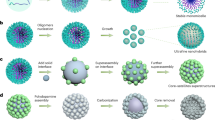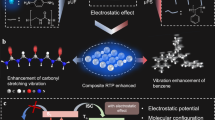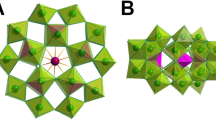Abstract
Herein, we report a straightforward technique for the creation of nanoporous polystyrene (PS) films. By preparing PS blend samples with Mws of 600 000 and 600 g mol−1 followed by rinsing with n-heptane, the low Mw component was dissolved and removed to afford a low-density network of high Mw PS. Nanoscale pores are formed as a result of the miscibility and stability of the initial state. The resulting materials were characterized using ellipsometry, atomic force microscopy and scanning electron microscopy. Materials with an effective refractive index as low as 1.1 can be prepared using this approach. The effects of varying the size of the low Mw polymer and the application of low friction surfaces prepared with the nanoporous samples were investigated.
Similar content being viewed by others
Log in or create a free account to read this content
Gain free access to this article, as well as selected content from this journal and more on nature.com
or
References
Foss, C. A., Hornyak, G. L., Stockert, J. A. & Martin, C. R. Optical-properties of composite membranes containing arrays of nanoscopic gold cylinders. J. Phys. Chem. 96, 7497–7499 (1992).
de Vos, R. M. & Verweij, H. High-selectivity, high-flux silica membranes for gas separation. Science 279, 1710–1711 (1998).
Germain, J., Fréchet, J. M. J. & Svec, F. Nanoporous polymers for hydrogen storage. Small 5, 1098–1111 (2009).
Schneider, K. & van Gassel, T. J. Membrandestillation. Chemie Ing. Tech. 56, 514–521 (1984).
Eustache, H. & Histi, G. Separation of aqueous organic mixtures by pervaporation and analysis by mass spectrometry or a coupled gas chromatograph-mass spectrometer. J. Memb. Sci. 8, 105–114 (1981).
Hulteen, J. C. & Martin, C. R. A general template-based method for the preparation of nanomaterials. J. Mater. Chem. 7, 1075–1087 (1997).
Chu, S.-Z., Wada, K., Inoue, S., Isogai, M. & Yasumori, A. Inside Front Cover: Fabrication of Ideally Ordered Nanoporous Alumina Films and Integrated Alumina Nanotubule Arrays by High-Field Anodization (Adv. Mater. 17/2005). Adv. Mater. 17, 2115–2119 (2005).
Lee, W., Ji, R., Gösele, U. & Nielsch, K. Fast fabrication of long-range ordered porous alumina membranes by hard anodization. Nat. Mater. 5, 741–747 (2006).
Tillotson, T. M. & Hrubesh, L. W. Transparent ultralow-density silica aerogels prepared by a two-step sol-gel process. J. Non Cryst. Solids 145, 44–50 (1992).
Lee, J., Hirao, A. & Nakahama, S. Polymerization of monomers containing functional silyl groups. 5. Synthesis of new porous membranes with functional groups. Macromolecules 21, 274–276 (1988).
Zhao, D., Feng, J., Huo, Q., Melosh, N., Fredrickson, G., Chmelka, B. & Stucky, G. Triblock copolymer syntheses of mesoporous silica with periodic 50 to 300 angstrom pores. Science 279, 548–552 (1998).
Hariharan, A., Kumar, S. K. & Russell, T. P. A lattice model for the surface segregation of polymer chains due to molecular weight effects. Macromolecules 23, 3584–3592 (1990).
Sauerbrey, G. Verwendung von Schwingquarzen zur Wagungdiinner Schichten und zur Mikrowagung. Z. Phys. 155, 206–222 (1959).
Köhler, A., Khan, A. L. T., Wilson, J. S., Dosche, C., Al-Suti, M. K., Shah, H. H. & Khan, M. S. The role of C-H and C-C stretching modes in the intrinsic non-radiative decay of triplet states in a Pt-containing conjugated phenylene ethynylene. J. Chem. Phys. 136 (2012).
Holinga, G. J., York, R. L., Onorato, R. M., Thompson, C. M., Webb, N. E., Yoon, A. P. & Somorjai, G. A. An SFG study of interfacial amino acids at the hydrophilic SiO2 and hydrophobic deuterated polystyrene surfaces. J. Am. Chem. Soc. 133, 6243–6253 (2011).
Prystupa, D., Anderson, A. & Torrie, B. H. Raman and infrared study of solid benzyl alcohol. J. Raman Spectrosc. 25, 175–182 (1994).
Bergner, G., Albert, C. R., Schiller, M., Bringmann, G., Schirmeister, T., Dietzek, B., Niebling, S., Schlücker, S. & Popp, J. Quantitative detection of C-deuterated drugs by CARS microscopy and Raman microspectroscopy. Analyst 136, 3686–3693 (2011).
Brandrup, J. & Immergut, E. H. Polymer Handbook, (John Wiley and Sons, New York, NY, USA, 1989).
Koros, W. J. & Fleming, G. K. Membrane-based gas separation. J. Memb. Sci. 83, 1–80 (1993).
Guillen, G. R., Pan, Y., Li, M. & Hoek, E. M. V. Preparation and characterization of membranes formed by nonsolvent induced phase separation: a review. Ind. Eng. Chem. Res. 50, 3798–3817 (2011).
Smolders, C. A., Reuvers, A. J., Boom, R. M. & Wienk, I. M. Microstructures in phase-inversion membranes. Part 1. Formation of macrovoids. J. Memb. Sci. 73, 259–275 (1992).
Radovanovic, P., Thiel, S. W. & Hwang, S.-T. Formation of asymmetric polysulfone membranes by immersion precipitation. Part II. The effects of casting solution and gelation bath compositions on membrane structure and skin formation. J. Memb. Sci. 65, 231–246 (1992).
Altena, F. W. & Smolders, C. A. Calculation of liquid liquid-phase separation in a ternary-system of a polymer in a mixture of a solvent and a nonsolvent. Macromolecules 15, 1491–1497 (1982).
Cohen, C., Tanny, G. B. & Prager, S. Diffusion-controlled formation of porous structures in ternary polymer systems. J. Polym. Sci. Polym. Phys. Ed. 17, 477–489 (1979).
Wong, T.-S., Kang, S. H., Tang, S. K. Y., Smythe, E. J., Hatton, B. D., Grinthal, A. & Aizenberg, J. Bioinspired self-repairing slippery surfaces with pressure-stable omniphobicity. Nature 477, 443–447 (2011).
Chen, W., Fadeev, A. Y., Hsieh, M. C., Öner, D., Youngblood, J. & McCarthy, T. J. Ultrahydrophobic and ultralyophobic surfaces: some comments and examples. Langmuir 15, 3395–3399 (1999).
Yao, X., Hu, Y., Grinthal, A., Wong, T.-S., Mahadevan, L. & Aizenberg, J. Adaptive fluid-infused porous films with tunable transparency and wettability. Nat. Mater. 12, 529–534 (2013).
Acknowledgements
Financial support from the Natural Sciences and Research Council of Canada is gratefully acknowledged. The research at the Perimeter Institute is supported by the Government of Canada through Industry Canada and the Province of Ontario through the Ministry of Economic Development and Innovation. JAF is grateful for the funding provided by the Paris Sciences Chair of the ESPCI, Paris, France.
Author information
Authors and Affiliations
Corresponding author
Ethics declarations
Competing interests
The authors declare no conflict of interest.
Rights and permissions
About this article
Cite this article
Lin, FY., Daley, C., Flannery, J. et al. Nanoporous polystyrene prepared via the selective removal of the low Mw component in polystyrene blends. Polym J 48, 983–990 (2016). https://doi.org/10.1038/pj.2016.68
Received:
Revised:
Accepted:
Published:
Issue date:
DOI: https://doi.org/10.1038/pj.2016.68



